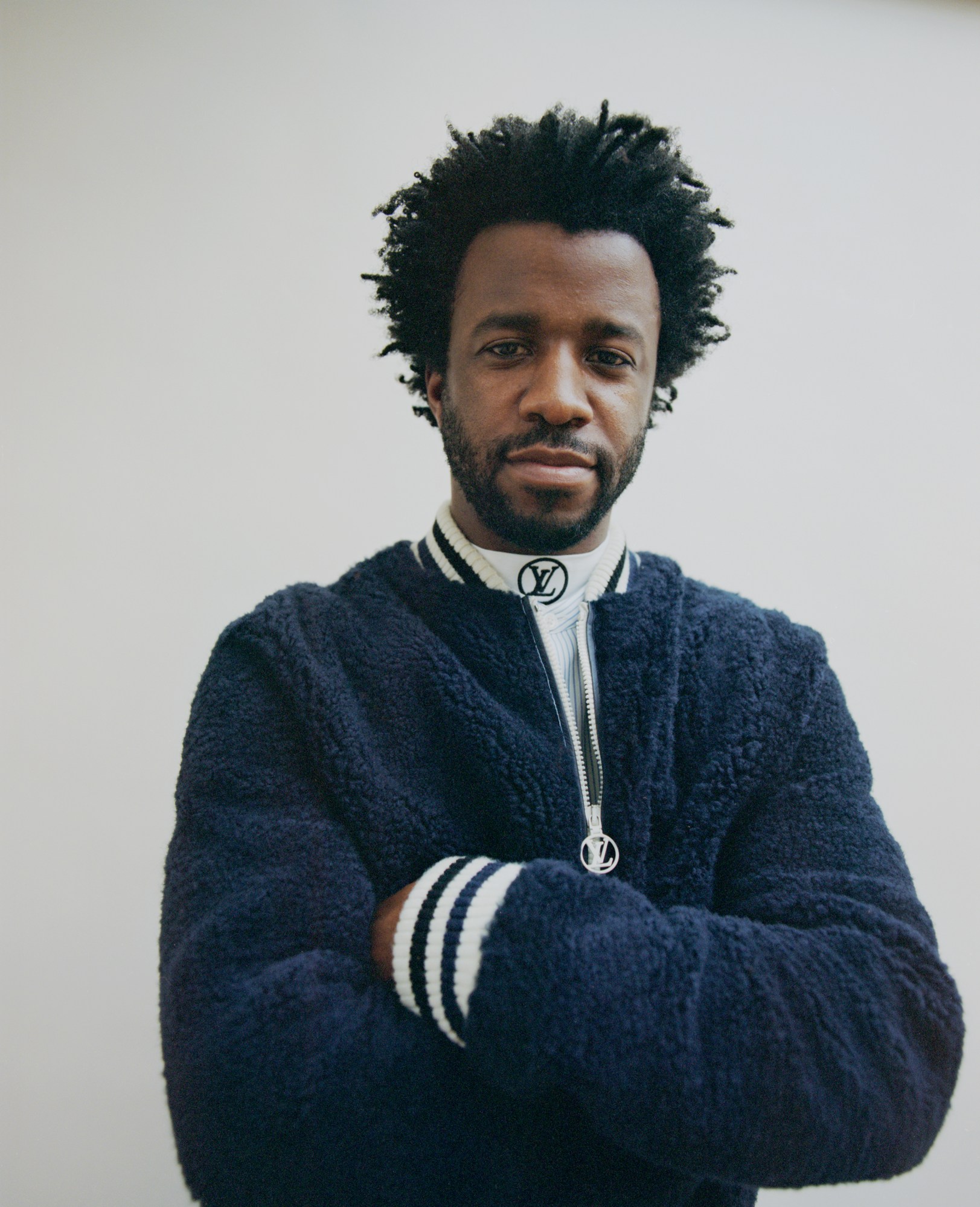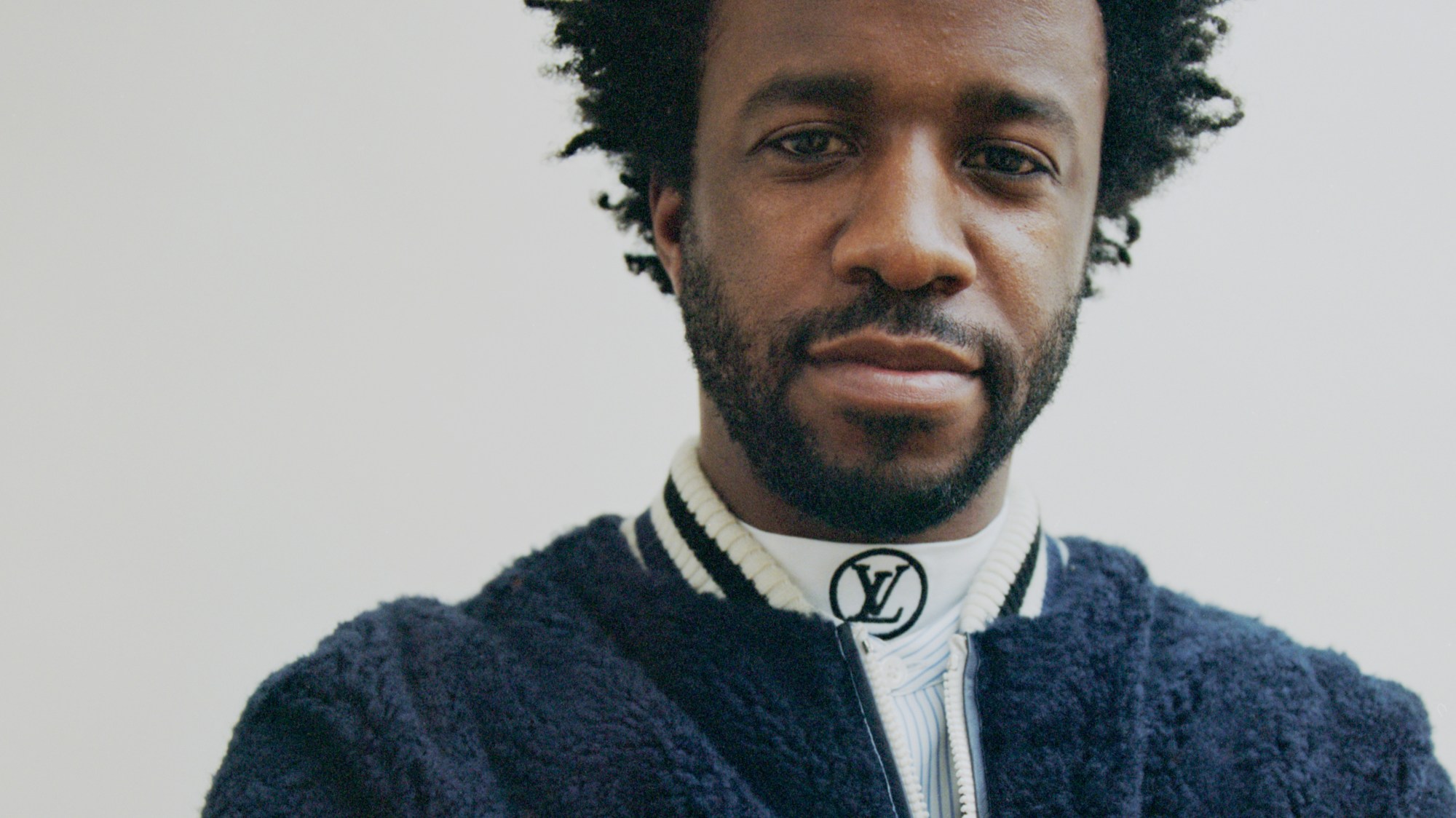This article originally appeared in The Radical Issue, no. 351, Spring 2018.
Simeon Barclay is not used to being photographed. The 43-year old is, in his capacity as one of Britain’s most semiotically-charged fine artists, more at home constructing the image himself; drawing on pop culture and his own childhood to better understand how we might mash and meld our identities to the world. “Being on the other side is almost…” He searches for the right word, as he does at several points in the conversation. “Like being Blu Tack,” he decides. “Moulded into shape.”
Born in the small Yorkshire town of Huddersfield in the mid-70s, Simeon grew up as the country was experiencing a sort of “cultural amnesia about itself”. No longer the colonial might it once was, Britain had become a nation of Thatcher, strikes and unrest. Of The Specials soundtracking nationwide malaise with a haunting Ghost Town on Top of the Pops.
His father was a tailor who’d come to the West Yorkshire town from the small Caribbean island of Carriacou in the 1950s. One of the earliest memories Simeon has of his dad is him arriving home after a shift at the mill, unfurling his tailoring equipment and carving out designs on a large baize table in the family living room. “We’d be the models, walking up and down and parading these garments,” he says. “I started to understand the power of fashion as a way of disturbing narratives, and for my father to do it all after a day of work…” He pauses. “That taught me that you could satisfy some sort of need if you really believed in it.”
At 14 Simeon discovered the narrative disturbing power of Vogue while working as a paperboy, and began to consume its monthly dose of fashion theatricality. He recalls, “The glamour of it, how it spoke to you as if you were already initiated in the discourse of what the magazine meant.” In the suffocating isolation of a small town, it was as though an entire world had opened up to him. “I guess it was like a portal,” he says. “But once you shut that magazine, you saw your surroundings and were stuck again. One day, I just closed the portal and went back on with life.”
Two weeks after leaving school, Simeon entered work at a local hydraulics factory. “I thought, I can keep my Dad off my back, follow that patriarchal way of being a man.” While he’d enjoyed art at school, at 16, as a second generation immigrant kid from a working class background — it just didn’t seem like an option. “I wouldn’t have known where to start,” he admits. “From where I came from, it was realistic to be a builder or a car mechanic. The artist didn’t exist.”

Over the next 16 years he found himself in a world defined by “the forming and performing of masculinity”. He’d be routinely challenged by what he describes as “a manly, hard as nails environment”, and recalls colleagues who would attempt to “shoot you down just as you were bringing your head over the parapet”. But Simeon resisted. “You play it safe at first because you want to get your feet in. Then you start to work out who you are and try to eke out a space to exist.” For him, that meant the time from which he clocked out at night, to when he clocked back in the morning, was dedicated to all the things that would signify his existence in the world. He and his peers would visit boutiques, nightclubs, spaces in which they could re-envision themselves. While for most people entering art, it could be a visit to a museum or a certain book that sets the ball rolling, Simeon was coming into it through a very different trajectory — living.
Like his father, he wanted to find something outside of work that could give him a purpose. He enrolled at night school and began an art A-level course, realising that his time in manufacturing had given him an ability to make things, to problem solve, to find connections. Over the next two years, he quietly built up enough of a profile to leave his job and take a place on the fine art course at London’s prestigious Goldsmiths College in 2010. There his work fell into the orbit of Morgan Quaintance, a curator and visiting tutor who saw something in the way Simeon drew on subjectivity, race and the damaging patriarchal ideals of masculinity, to rewrite stories from the perspective of a black, working class, northern male. It was, in a way, what he’d been doing his whole life — navigating the world with nuance and complexity in an attempt to avoid categorisation.
Following an acclaimed show, They Don’t Like It Up ‘Em’ at London’s Cubitt, and an award from the Liverpool Biennial Associate Artists Programme, Simeon was invited to present his work as part of Tate Britain’s Art Now series. His exhibition there late last year was a triumph of a perspective often ignored, sidelined, or at least cheapened by the art world. The Hero Wears Clay Shoes mixed text, images and industrial materials to concise and potent effect, drawing on cultural artefacts as disparate as Viz comics, Diego Maradona, Boys from the Blackstuff and old Calvin Klein advertisements. It was a portrait of a time and a place and a way of living.
“I think I always had delusions of grandeur,” he says today, the acclaimed artist who finally managed to eke out a space for himself. “I just knew there was something out there. I knew I had more to give.” Then he pauses to choose his words for the final time. “Maybe it was all that Top of the Pops.”

Credits
Photography Nadine Ijewere
Styling Nicco TorellI
Hair Hirokazu Endo using Bumble and bumble. Make-up Amy Conley at Stella Creative using CHANEL Rouge Coco Lip Blush and Serum Eye. Photography assistance James Gilbert. Styling assist ance Pensira Kira Nakan. Production Roberta Arcidiacono.
